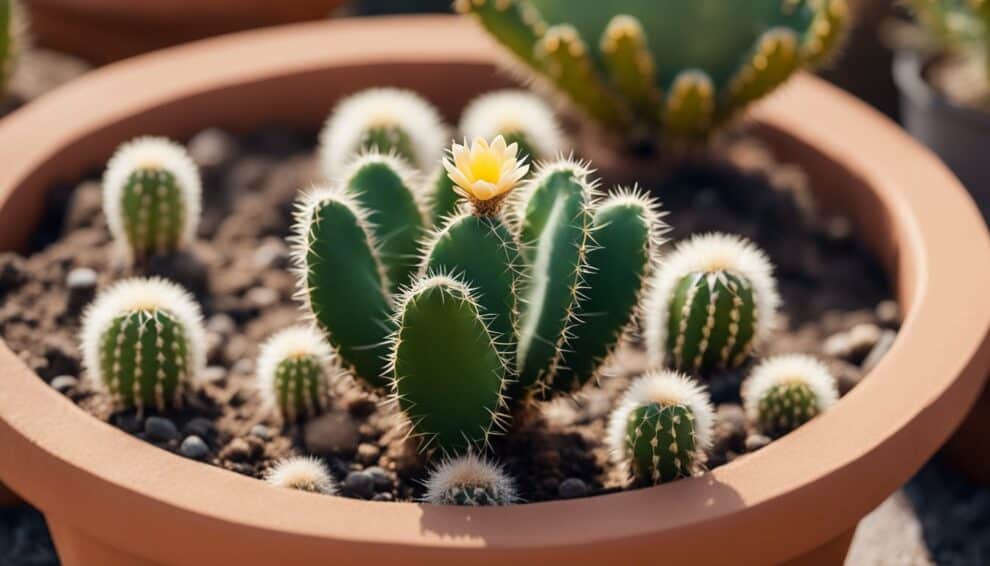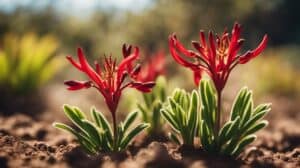Bunny Ear Cactus, scientifically known as Opuntia microdasys, is a popular species among cacti enthusiasts.
This cactus is native to Mexico and Central America, and it is well-known for its unique appearance that resembles bunny ears.
Bunny Ear Cactus is a relatively easy plant to care for, making it an excellent choice for beginners.

One of the most exciting things about Bunny Ear Cactus is that it is straightforward to propagate.
Propagation is the process of growing new plants from existing ones.
Bunny Ear Cactus can be propagated through stem cuttings, which can be rooted in soil or water.
This makes it easy for cacti lovers to increase their collection and share their plants with friends and family.
In this article, we will provide some care tips for Bunny Ear Cactus propagation and maintenance.
Understanding Bunny Ear Cactus
Species Overview
Bunny Ear Cactus, also known as Opuntia microdasys, is a species of cactus native to Central and Northern Mexico.
It is a popular ornamental plant due to its unique appearance and ease of care.
The cactus is characterized by its flat, round pads that resemble bunny ears, hence its common name.
The pads are covered in small, fuzzy spines called glochids, which can cause irritation if they come into contact with skin.
Growth Habits
Bunny Ear Cactus is a relatively small cactus, typically growing to a height of 6-18 inches (15-45 cm) and a width of 12-18 inches (30-45 cm).
It is a slow-growing plant that can take several years to reach its full size. The cactus prefers bright, indirect sunlight and well-draining soil.
It can tolerate a wide range of temperatures, but prefers to be kept in a warm, dry environment.
Bunny Ear Cactus is a hardy plant that can survive in a variety of conditions. It is drought-tolerant and can go for long periods without water.
However, it is important to avoid over-watering, as this can lead to root rot.
The cactus also benefits from occasional fertilization during the growing season.
Overall, Bunny Ear Cactus is an easy-to-care-for plant that is perfect for beginners and experienced gardeners alike.
With proper care, it can thrive for many years, adding a unique touch to any indoor or outdoor space.
Propagation Methods

Pad Preparation
To propagate Opuntia Microdasys, one can use the pads of the cactus.
It is important to choose a healthy pad that is free from any signs of damage or disease.
The pad should be cut with a clean, sharp knife, and left to dry for a few days until the cut end has calloused over.
This will help prevent the pad from rotting when it is planted.
Rooting Techniques
Once the pad has calloused over, it is ready to be planted. There are several methods for rooting the pad, including placing it directly into soil or water.
To root in soil, create a small hole in the soil and place the pad in the hole, making sure it is firmly in place.
To root in water, place the pad in a container with water, making sure that the bottom of the pad is submerged in the water.
It is important to change the water regularly to prevent the growth of bacteria.
Aftercare for New Plants
After the pad has been planted, it is important to provide it with the proper care to ensure that it roots successfully.
The plant should be placed in a warm, sunny location and watered sparingly. Overwatering can cause the plant to rot.
Once the plant has established roots, it can be watered more frequently. It is also important to fertilize the plant regularly to promote healthy growth.
Overall, propagating Opuntia Microdasys is a simple process that can be done using the pads of the cactus.
With proper preparation, rooting techniques, and aftercare, new plants can be easily grown, adding to your collection of beautiful cacti.
Optimal Growing Conditions

Lighting Requirements
The Bunny Ear Cactus, also known as Opuntia Microdasys, requires plenty of bright, direct sunlight to thrive.
It is recommended to place the cactus in an area that receives at least six hours of sunlight per day.
If grown indoors, it is best to place the cactus near a south-facing window or under grow lights.
Watering Schedule
The Bunny Ear Cactus is a drought-tolerant plant and requires infrequent watering. Overwatering can lead to root rot and damage the plant.
It is recommended to water the cactus only when the soil is completely dry.
During the growing season, which is from spring to fall, water the cactus once a week. In the winter, reduce watering to once every two to three weeks.
Soil and Fertilization
The Bunny Ear Cactus prefers well-draining soil, such as a mixture of sand, perlite, and peat moss.
It is important to avoid using heavy, clay-based soil as it can retain too much moisture and cause root rot.
Fertilization is not necessary for the cactus, but a diluted, balanced fertilizer can be applied during the growing season.
Temperature and Humidity
The Bunny Ear Cactus thrives in warm temperatures and low humidity.
It is recommended to keep the cactus in an area with temperatures between 70-85°F (21-29°C).
The cactus can tolerate cooler temperatures down to 50°F (10°C) but should be protected from frost.
High humidity can lead to fungal diseases, so it is best to keep the cactus in a dry area with good air circulation.
By providing the optimal growing conditions of bright, direct sunlight, infrequent watering, well-draining soil, warm temperatures, and low humidity, the Bunny Ear Cactus can thrive and produce healthy, vibrant growth.
Frequently Asked Questions

How can I propagate a Bunny Ear Cactus successfully?
Propagating a Bunny Ear Cactus can be done through stem cuttings.
When taking a cutting, make sure to use a clean, sharp knife or scissors and let the cut end dry for a few days before planting it in well-draining soil.
It’s important to keep the soil slightly moist and in a warm, bright location until the cutting has rooted and begun to grow.
What are the ideal lighting conditions for a Bunny Ear Cactus?
Bunny Ear Cacti thrive in bright, indirect light. They can tolerate some direct sun, but too much can cause sunburn and damage to the plant.
It’s best to place them near a window that receives morning or afternoon sun, or to provide them with bright artificial light.
What are common issues with Bunny Ear Cactus and how can I prevent them?
Overwatering is a common issue with Bunny Ear Cacti, as they are susceptible to root rot.
It’s important to let the soil dry out completely between waterings and to avoid getting water on the plant’s leaves.
Additionally, pests such as mealybugs and spider mites can be a problem.
Regularly inspecting the plant and treating any infestations promptly can help prevent damage.
How often should I water my Opuntia microdasys?
Bunny Ear Cacti prefer to be watered infrequently, typically every 2-3 weeks.
It’s important to let the soil dry out completely between waterings to prevent root rot.
What is the expected lifespan of a Bunny Ear Cactus?
With proper care, Bunny Ear Cacti can live for several decades. They are slow-growing plants and can take several years to reach maturity.
Can Bunny Ear Cactus bloom, and if so, how do I encourage flowering?
Yes, Bunny Ear Cacti can bloom. They typically produce small yellow flowers in the spring and summer.
To encourage flowering, make sure the plant is receiving enough light and is not being overwatered.
Additionally, fertilizing the plant with a cactus-specific fertilizer during the growing season can help promote blooming.













